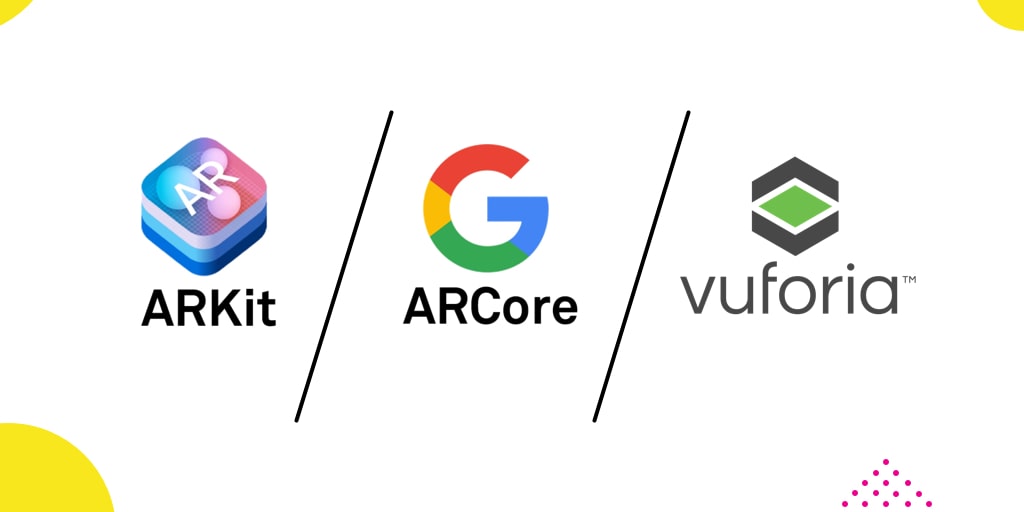Augmented reality is one of the most popular trends in app development today. This is because AR apps offer higher user engagement and interactive user experience.
AR apps are getting popular in all major industries. Studies show that the AR market is expected to reach USD 60.55 billion by 2023 (Source). Businesses are leveraging AR in apps for virtual shopping, industrial equipment fixing, education/training, design/modeling, car maintenance/repair, gaming, and more.
The rising popularity of AR in app development can also be attributed to the two major tech giants like Apple and Google that developed their own AR development toolkits with frameworks and SDKs to include ARKit and ARCore, respectively. Similarly, PTC developed Vuforia that is gaining immense popularity in AR development.
ARKit, ARCore, and Vuforia are among the most popular toolkits that facilitate the tools needed to build an augmented reality app. These have simplified AR app development. While all of these have good capabilities to offer, there are minor points of difference that developers must know and consider while choosing the right tools, framework, and SDKs for AR app development!
So, let’s see here the features of these three popular AR development toolkits!
#ARKit
ARKit by Apple is a toolkit or a set of tools (framework and SDKs) that help developers in building AR apps for the iOS platform to include iPhones 6 and above models and iPad Pro models.
The prominent offerings of ARKit are points, plane detection, AR world map, light estimation, anchors, face tracking, motion capture, people occlusion, and collaboration sessions.
ARKit supports image detection and image tracking and helps embed virtual objects into AR experiences or on surfaces. This immediately reminds of the popular IKEA Place AR app, doesn’t it? Another common example of ARKit use for an augmented reality app is the Pokemon Go game app.
The major benefit of ARKit for developers over other popular AR development tools is the Apple ecosystem that makes development easier. Moreover, it offers frequent updates and new features for more exciting app development opportunities.
But, as discussed, a significant limitation with ARKit for app development is the fact that its use is limited to the iOS platform that too iPhone 6s+ and iPad Pro+ only. Besides, it cannot handle motion capture for very fast motion.
ARKit is available at $99 per year for AppStore distribution.
#ARCore
ARCore is Google’s toolkit (framework and SDK) for creating augmented reality apps. The best thing about ARCore is that it supports development for both Android (7.0 and higher) & iOS platforms (11 or higher). Plus, this AR development toolkit is available for free!
ARCore offers points, plane detection, pose, light estimation, anchors, image tracking, face tracking, object occlusion, and cloud anchors. These capabilities and results are similar to ARKit.
With ARCore’s motion tracking capabilities, developers can track the phone’s position relative to the surroundings. Other important capabilities of ARCore are environmental understanding to include detecting size and location of surfaces and light estimation including real-life lighting conditions.
With the capabilities of real-time position tracking and integration of virtual and real objects, ARCore is a great tool for AR in e-commerce apps. It lets you place objects and text within physical surroundings.
For example, note how eBay benefitted by utilizing augmented reality and ARCore! Sellers on eBay can use AR to choose the right box size. With the help of ARCore, this app allows the users to superimpose different size boxes over the item and find the perfect fit to avoid wastage and reduce shipping costs.
A popular Android application utilizing ARCore is Google Playground. This helps Android users play with the world around with their cameras. With Google Playground, users get an amazing AR experience and make their photos and videos come alive with animated characters called Playmojis.
Among the many such examples, another great ARCore use-case for augmented reality is in the real estate industry, for example, the Curate AR App by SRI (Sotheby’s Realty Immersive AR app). This app allows the users to see how furniture and decor will look, feel, and fit in the prospective property. Besides, with this app, the real-estate agents no longer need to spend on renting/buying and storing furniture to physically stage homes for attracting buyers.
#Vuforia
Vuforia supports Android, iOS, UWP, and Unity Editor. This AR development toolkit from PTC is another good option for AR app developers to track predefined images, models, objects, or 3D scans.
Vuforia can run on both iOS and Android and even iPhone’s older models that ARKit is not compatible with. Also, Vuforia uses ARKit or ARCore when the hardware it’s running on supports it, else it can utilize its own platform.
Vuforia’s main capabilities are object and image tracking for AR development. Vuforia platform offers object detection from provided targets for recognition and thus enables the developers to upload models, images, object scans, and other support target types for detection.
This tool helps the recognition of different object types like boxes, cylinders, and planes. It also provides text and environment recognition. Another significant capability offered by Vuforia is VuMark that is a combination of picture and QR code. Developers can scan and create object targets with Vuforia Object Scanner.
Some examples of Vuforia use-cases are Vuforia View and Vuforia Chalk. Vuforia offers a free developer tier with 1000 cloud recognitions and 1000 targets per month, but with Vuforia watermarks. Paid plans are available without watermarks starting from $99 per month for 1000 cloud recognitions and 100,000 targets.
ARKit vs ARCore vs Vuforia – Comparison
ARKit, ARCore, and Vuforia are all popular AR development toolkits. ARKit supports only iOS platform while ARCore and Vuforia support both iOS and Android. Statistics show that 78% of the global mobile gaming market is of Android gamers (Source). The iOS platform limitation thus leaves ARKit with one major drawback in comparison to the other two!
Comparing further, ARKit and ARCore both offer equivalent results and capabilities in lighting estimation, but the approach is different. While ARKit provides the developers with the color temperature and intensity, ARCore provides a shader or value of the pixel intensity with the Unity API and Android Studio API respectively.
For simultaneous localization and mapping, ARKit fares better in reliable tracking and ARCore leads in mapping and reliable recovery. As ARCore maintains larger maps, if the user’s device loses tracking ARCore will recover the map more reliably.
In hardware requirements, ARCore fares better as it supports many existing devices eliminating the need for any specific hardware, e.g. a specialized camera or sensor.
Though Vuforia has limited capabilities in comparison to ARKit and ARCore, it offers a major advantage over ARKit and ARCore that largely balances the limitations of Vuforia. It has been designed to utilize the benefits of both ARCore and ARKit through Vuforia Engine. As Vuforia Engine leverages ARCore and ARKit (or even AR Foundation) to empower features within the SDK, with Vuforia Engine 7.2 (or later), developers can automatically take advantage of both ARKit and ARCore in their project through the Vuforia Engine Library.
Note that as already discussed, pricing is also a comparison factor worth considering between the three, ARKit, ARCore, and Vuforia!
Wrapping Up
Augmented reality has opened new paths in app development for its ability to provide a mesmerizing user experience. For developers, integrating AR into the apps has become easy with the AR development toolkits like ARKit, ARCore, and Vuforia.
All these toolkits are great in terms of overall capabilities and features they provide in developing AR apps. For general AR development, developers can choose between these based on the platform to be used and the pricing. For unique and complex functionalities, it becomes important to know the minute points of difference between these tools.
Moreover, ARKit is being constantly developed by Apple with improvement and new features added regularly, which make it a preferred choice among developers. But, ARCore is a free tool and carries the advantage of multi-platform compatibility. Vuforia is costly, but it offers the advantage of pairing up and leveraging the features of ARKit and ARCore and is multi-platform too.
Considering these factors, choose the right toolkit for your next AR project! Learn more about augmented reality tools and SDKs.






